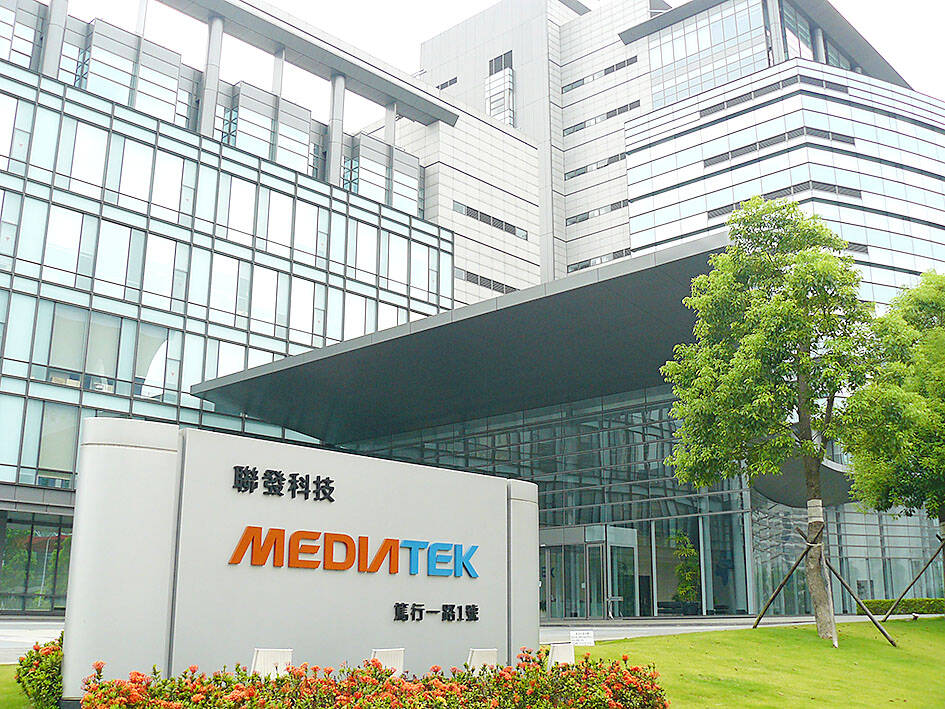Chip designer MediaTek Inc (聯發科) yesterday reported its best profit in five quarters, thanks to stronger-than-expected demand for its flagship smartphone chips.
Net profit last quarter jumped 38.9 percent sequentially and 38.8 percent annually to NT$25.66 billion (US$819.8 million), as its gross margin improved to 48.3 percent from 47.4 percent the previous quarter and 48.3 percent a year earlier.
On an annual basis, however, net profit slid 34.8 percent to NT$76.98 billion from NT$118.14 billion in 2022.

Photo: CNA
Earnings per share dropped to NT$48.51 from NT$74.95 the prior year, although the figure remains the third-highest in the company’s history, it said.
Gross margin last year slid to 47.8 percent from 49.4 percent in 2022, MediaTek said.
The Hsinchu-based company expects a “year of growth” this year, driven by its flagship smartphone chips.
Flagship smartphone chip revenue is expected to see “very strong” double-digit percentage growth this year on an annual basis, following last year’s 70 percent growth to more than US$1 billion, MediaTek said.
Gross margin is estimated to reach between 45.5 percent and 48.5 percent, the company said.
“We also observe that generative artificial intelligence [AI] is driving smartphone upgrades and creating a bigger market for flagship and high-end smartphones,” MediaTek CEO Rick Tsai (蔡力行) said at a teleconference. “The continuous 5G migration and market share expansion of our flagship chips will be key drivers for our mobile phone business this year.”
Chinese smartphone vendors Oppo Mobile Telecommunications Corp (歐珀), Xiaomi Corp (小米) and iQoo adopted MediaTek’s flagship Dimensity 9300 chip for their premium phones with generative AI features, Tsai said.
The company also extended generative AI to its premium segment with Dimnesity 8300, he said.
As the company continues to explore new growth engines, it expects several new businesses to begin volume production from late next year, he said.
With that, MediaTek sees this year as the beginning of its next growth trajectory, he added.
The company expects global smartphone shipments this year to grow at a low-single-digit percentage to 1.2 billion units, with 5G models’ penetration rate climbing to the low-60s from a high 50s in terms of percentage last year.
The company’s revenue this quarter is forecast to grow between 27 and 35 percent annually to between NT$121.8 billion and NT$129.6 billion, as inventories return to normal throughout the supply chain, it said.
Sequentially, revenue this quarter would be flat to down 6 percent from NT$129.56 billion last quarter. Mobile phone chips made up about 64 percent of last quarter’s revenue, the company said.
MediaTek yesterday promoted chief financial officer David Ku (顧大為) to double as a chief operating officer (COO), together with Joe Chen (陳冠州), ushering in a corporate structure with two COOs supervising its operations.
The personnel adjustments take effect today.

In a high-security Shenzhen laboratory, Chinese scientists have built what Washington has spent years trying to prevent: a prototype of a machine capable of producing the cutting-edge semiconductor chips that power artificial intelligence (AI), smartphones and weapons central to Western military dominance, Reuters has learned. Completed early this year and undergoing testing, the prototype fills nearly an entire factory floor. It was built by a team of former engineers from Dutch semiconductor giant ASML who reverse-engineered the company’s extreme ultraviolet lithography (EUV) machines, according to two people with knowledge of the project. EUV machines sit at the heart of a technological Cold

Taiwan’s long-term economic competitiveness will hinge not only on national champions like Taiwan Semiconductor Manufacturing Co. (TSMC, 台積電) but also on the widespread adoption of artificial intelligence (AI) and other emerging technologies, a US-based scholar has said. At a lecture in Taipei on Tuesday, Jeffrey Ding, assistant professor of political science at the George Washington University and author of "Technology and the Rise of Great Powers," argued that historical experience shows that general-purpose technologies (GPTs) — such as electricity, computers and now AI — shape long-term economic advantages through their diffusion across the broader economy. "What really matters is not who pioneers

Taiwan Semiconductor Manufacturing Co (TSMC, 台積電) last week recorded an increase in the number of shareholders to the highest in almost eight months, despite its share price falling 3.38 percent from the previous week, Taiwan Stock Exchange data released on Saturday showed. As of Friday, TSMC had 1.88 million shareholders, the most since the week of April 25 and an increase of 31,870 from the previous week, the data showed. The number of shareholders jumped despite a drop of NT$50 (US$1.59), or 3.38 percent, in TSMC’s share price from a week earlier to NT$1,430, as investors took profits from their earlier gains

TAIWAN VALUE CHAIN: Foxtron is to fully own Luxgen following the transaction and it plans to launch a new electric model, the Foxtron Bria, in Taiwan next year Yulon Motor Co (裕隆汽車) yesterday said that its board of directors approved the disposal of its electric vehicle (EV) unit, Luxgen Motor Co (納智捷汽車), to Foxtron Vehicle Technologies Co (鴻華先進) for NT$787.6 million (US$24.98 million). Foxtron, a half-half joint venture between Yulon affiliate Hua-Chuang Automobile Information Technical Center Co (華創車電) and Hon Hai Precision Industry Co (鴻海精密), expects to wrap up the deal in the first quarter of next year. Foxtron would fully own Luxgen following the transaction, including five car distributing companies, outlets and all employees. The deal is subject to the approval of the Fair Trade Commission, Foxtron said. “Foxtron will be